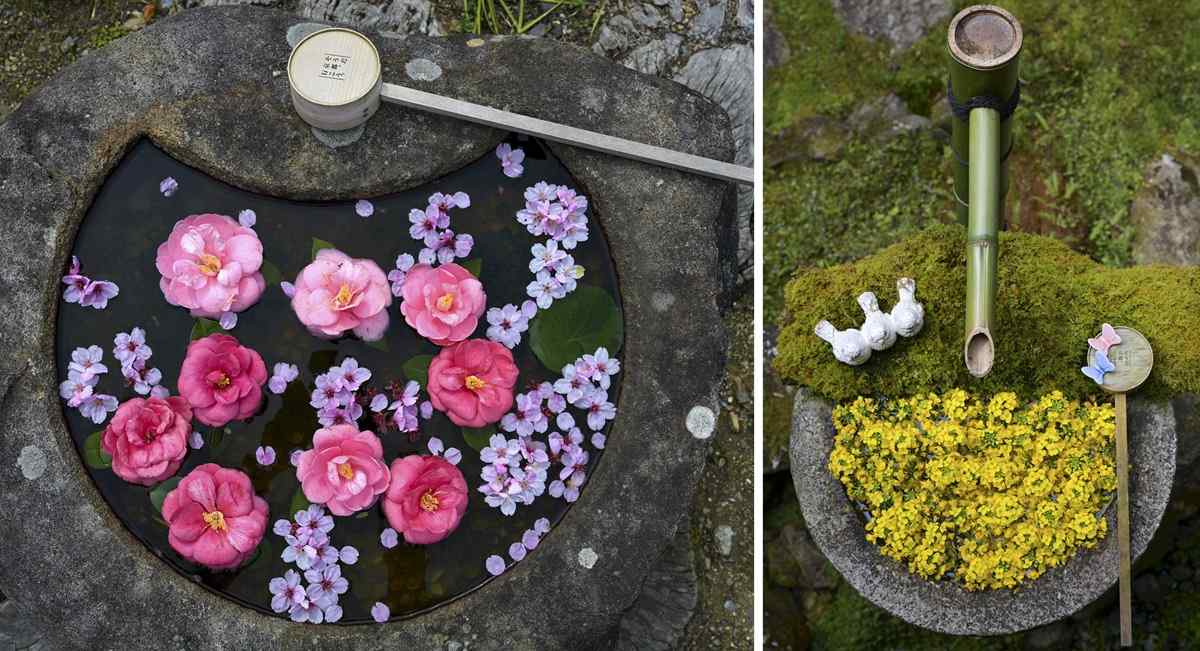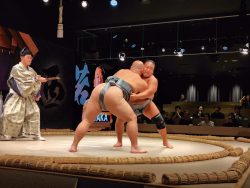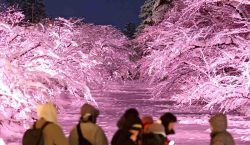
Women take photos of colorful flowers in a “hanachozu” at Yanagidani Kannon Yokokuji Temple in Nagaokakyo, Kyoto Prefecture.
11:26 JST, May 4, 2024
NAGAOKAKYO, Kyoto — At a temple or shrine in Japan, you have probably seen a pavilion sheltering a fountain with water trickling out. The water is called chozu, which is for people to clean their hands and mouths before worshipping. The structure is called chozuya.
When I passed through a temple gate, a hanachozu caught my eyes. A “hanachozu” is a chozu decorated with hana, or flowers. In the chozuya, a thin stream of water flowed from a dragon-head faucet. Field mustard and cherry petals covered the surface of the water. Women took photos with their smartphones.
“Oh, how beautiful,” exclaimed one of them.
Yanagidani Kannon Yokokuji Temple in Nagaokakyo, Kyoto Prefecture, is believed to be the place where hanachozu practice began.
“We started doing it just for fun,” said Megumi Kusaka, 54, wife of Shunei Kusaka, 55, chief priest of the temple.
The temple is in a mountainous area about a 15-minute drive from the center of the city. Megumi was born and raised at the temple, which is believed to cure eye diseases. It has attracted the faith of those suffering from eye problems since long ago, but the number of visitors has since decreased and the temple buildings have aged. Megumi worried that the temple might become obsolete.

Left: Camellia and cherry petals are placed together. Right: Yellow petals form a beautiful contrast with moss.
In the summer of 2017, when Megumi was looking around the garden, she suddenly felt like adding color to it. She wanted to plant kikyo, or balloon flowers, but was not allowed to because the temple was designated as a place of scenic beauty by Kyoto Prefecture. When she asked for permission from the prefectural government, an official told her that new plants must be added carefully.
So instead, Megumi cut hydrangea flowers and floated them on the surface of the chozu water. The vivid colors were remarkable, forming a contrast with the moss-covered chozu container. She thought the scene looked so pretty and decorated the basin with various grasses and flowers. Megumi posted the photos on social media and named the decoration hanachozu.
In autumn that year, she put red, yellow and green leaves in gradation over the entire surface of the water in the basin. The scene went viral after a photo of the hanachozu that a worshiper posted on social media got 100,000 likes. Since then, many visitors holding cameras have visited the temple, and the number of them has rapidly risen.
“Putting flowers on the water calms my mind. Nothing else makes me more delighted than the smiles of visitors seeing the flowers,” said Megumi.
Initially, some criticized her. One person said, “The water should be for purifying worshipers,” and another said, “The water can’t be used [for handwashing] like this.” But when the COVID-19 pandemic began, many other temples removed ladles for chozu as measures to prevent infections and instead decorated the chozu with flowers from each season.
Shunei says that the word, hanachozu, originally meant cleansing the hands with grass or flowers outdoors instead of water. However, the word has now become familiar to people in a different way: as a new way of mental healing.
“I hope visitors can get rid of their frustrations even just a little and become optimistic,” the chief priest said.
Visitors to the temple can walk around in the vast precincts surrounded by mountains. Now, Soshi, 23, the eldest son of the couple, has joined the work to create hanachozu, and there are nine hanachozu sites at the temple. It is enjoyable to look for the sites with the temple’s guide pamphlet in hand.
Seeing the hanachozu makes visitors forget the passage of time as they feel like they are looking at a piece of art. Under gentle sunlight, the flowers can be seen here and there.
Eye-healing water

Jigen-ame candies, popular souvenirs from the temple
Water from a spring in the temple’s precincts is believed to heal eye diseases. According to temple records, about 1,200 years ago, Buddhist monk Kukai witnessed an adult monkey washing the injured eye of its infant with the spring water. When Kukai offered a prayer, the infant’s eye opened again. Kukai dug the ground of the site deeper and made the spring water spiritual water for people suffering from eye diseases.
Many people visit the temple and obtain the spring water. They are allowed to bottle the water to take home. The temple also sells amulets and talismans to pray for recovery from eye diseases. A popular souvenir is jigen-ame candy. A set contains eight pieces each and is priced at ¥400.
How to get there
The temple is about a 15-minute drive from Nagaoka-tenjin Station on the Hankyu Line or JR Nagaokakyo Station. In June, the temple holds Ajisai Week, when visitors can enjoy seeing about 5,000 flowering hydrangea flowers, and its Kamishoin hall is opened to the public as a special exhibition. Admission is usually ¥500, but is ¥700 during the Ajisai Week period. Entry to the Kamishoin hall requires a surcharge.

"Features" POPULAR ARTICLE
-

Students Recreate 19th-Century Bento Boxes Made for Ino Tadataka’s Survey Team in Hot Spring Town on Nakasendo Road
-

Santa Claus Delivers Christmas Presents to Penguins at Aquarium in Japan’s Nagasaki Prefecture
-

Sumo Restaurant in Tokyo Teaches Foreign Visitors About the Ancient Sport, with Bouts Between Retired Rikishi
-

Autonomous Passenger Ship Connects Mainland with Remote Island in Seto Inland Sea; World’s 1st Commercially Operated Autonomous Vessel
-

Osaka’s Sumiyoshi Taisha Shrine Bustles with New Year’s Visitors
JN ACCESS RANKING
-

As Chinese Tourists Shun Japan, Hotels and Stores Suffer
-

Osaka-Kansai Expo’s Economic Impact Estimated at ¥3.6 Trillion, Takes Actual Visitor Numbers into Account
-

Japan Govt Adopts Measures to Curb Mega Solar Power Plant Projects Amid Environmental Concerns
-

BOJ Gov. Ueda: Highly Likely Mechanism for Rising Wages, Prices Will Be Maintained
-

Economic Security Panels Debate Supply Chains, Rare Earths; Participants Emphasize Importance of Cooperation Among Allies

























